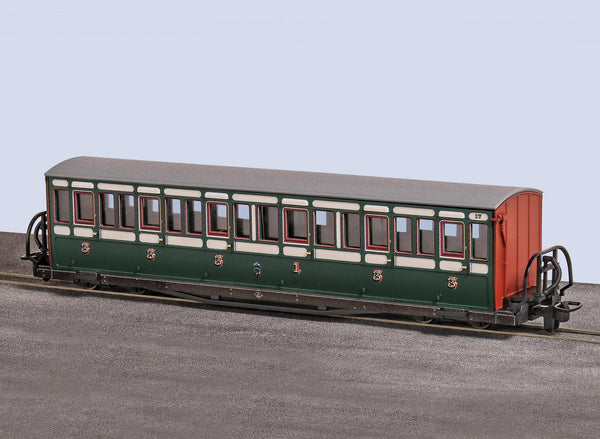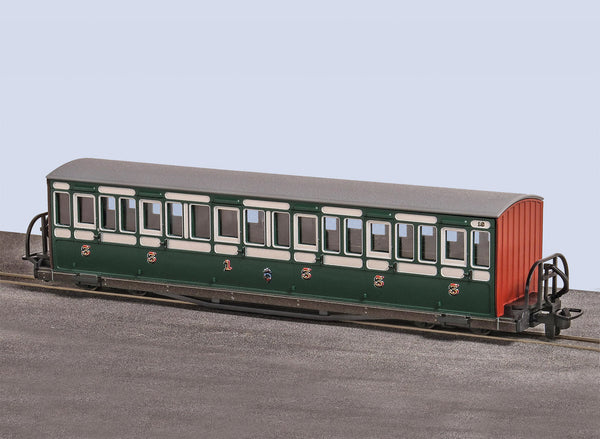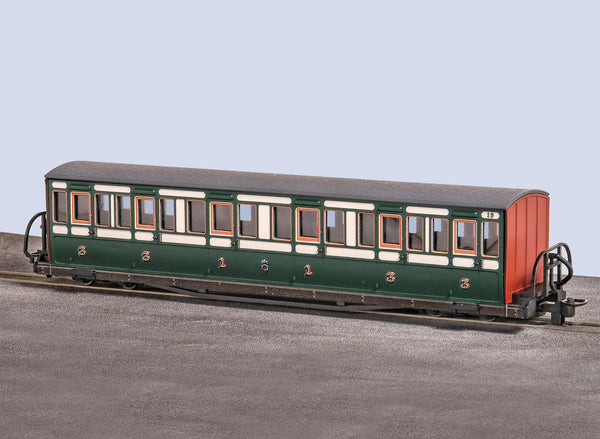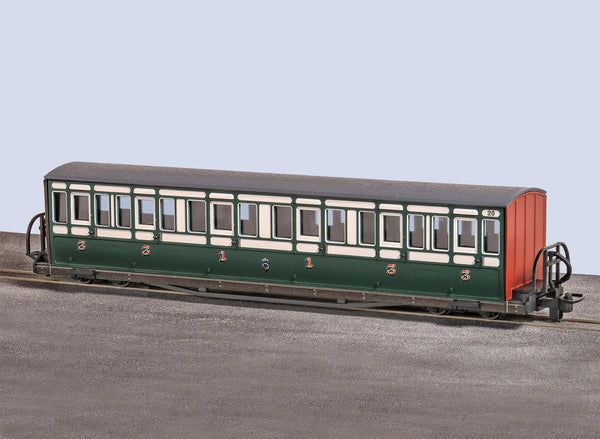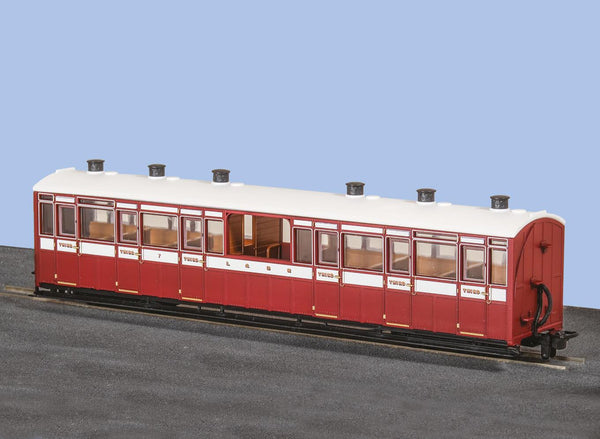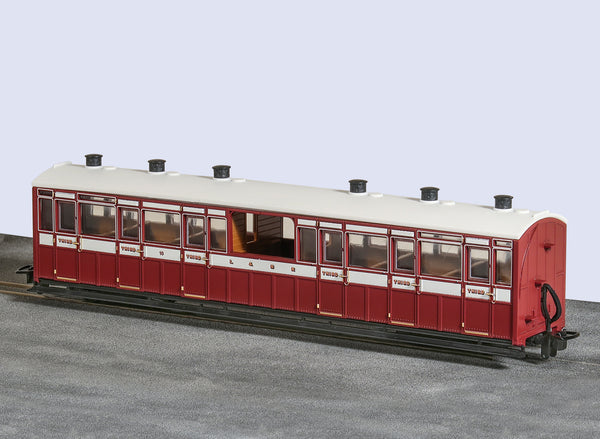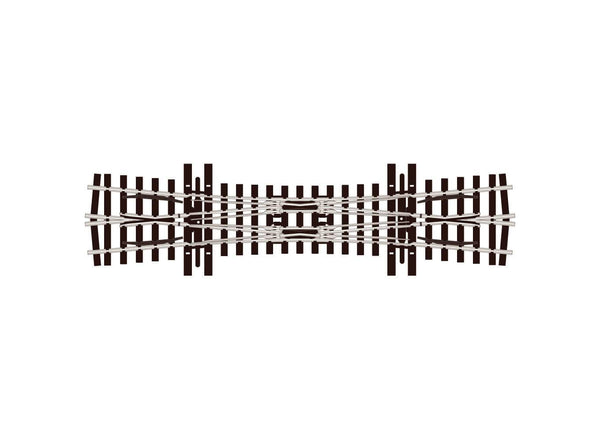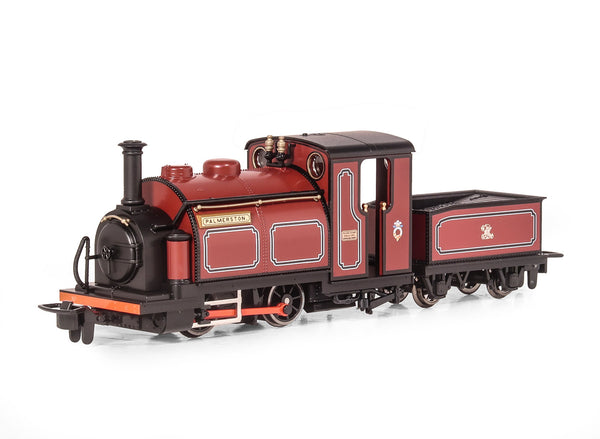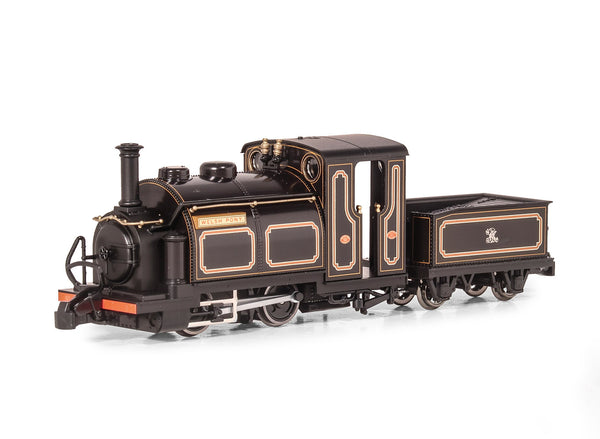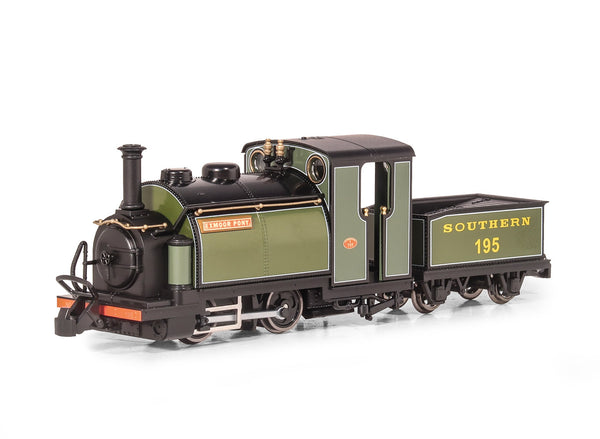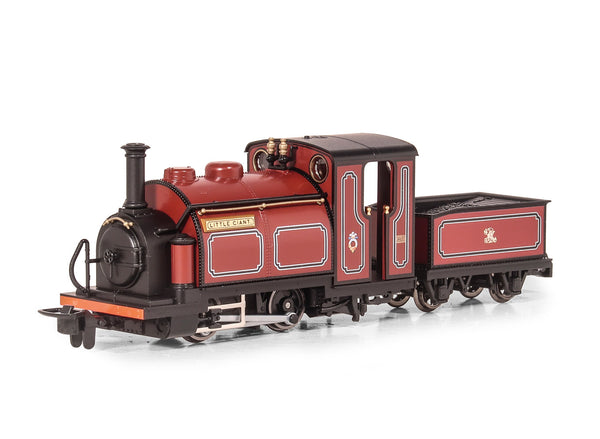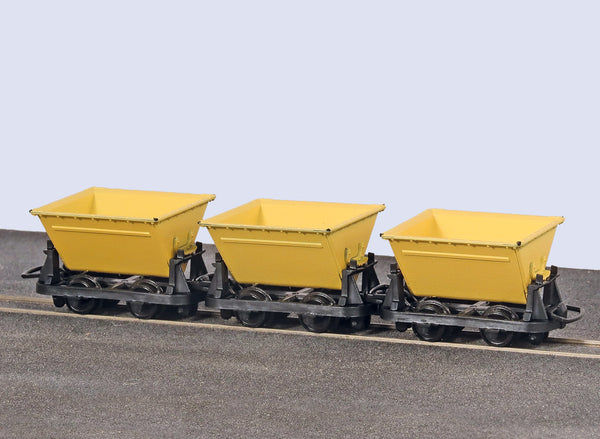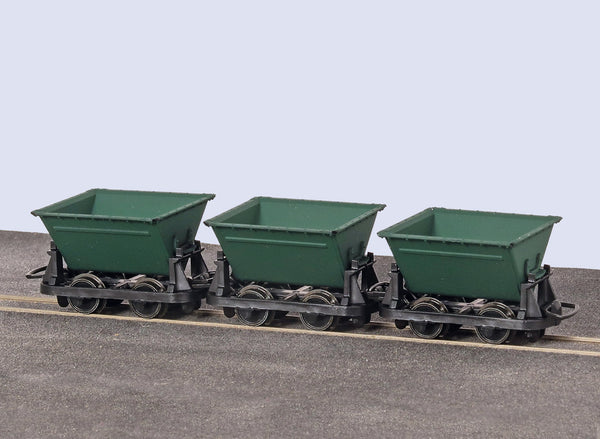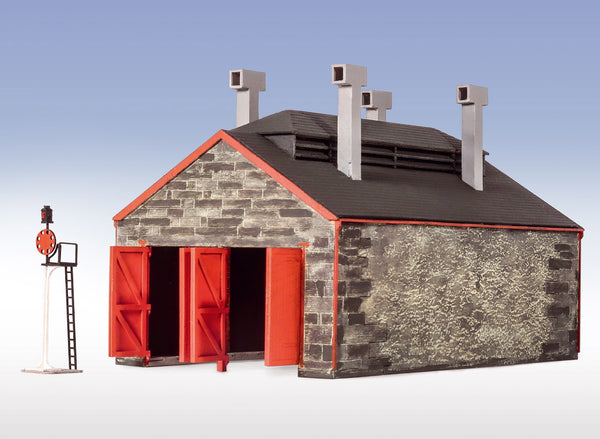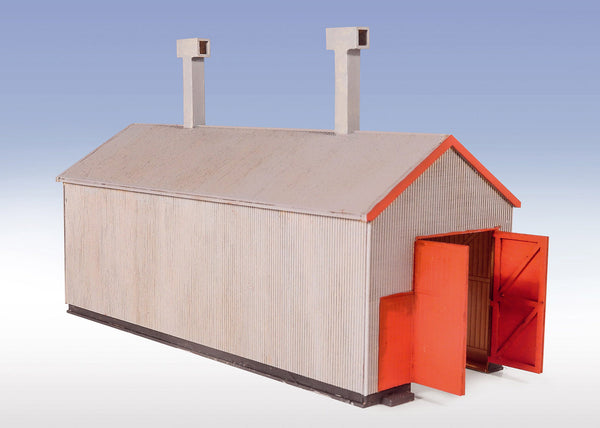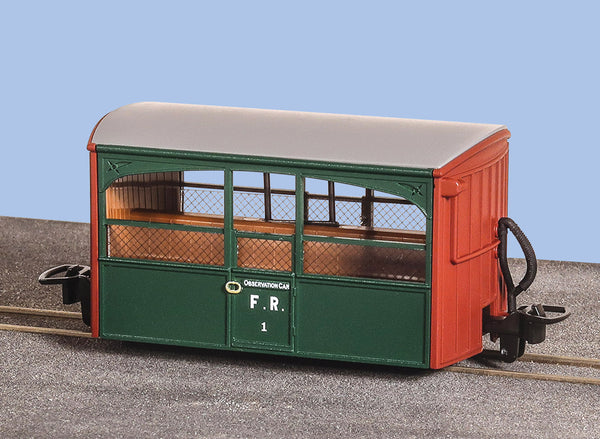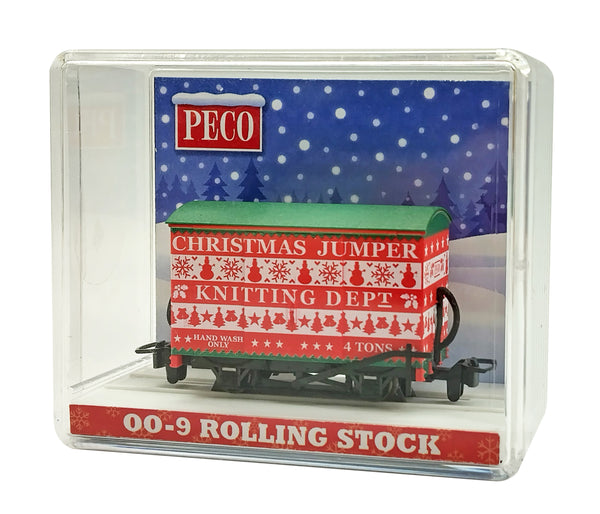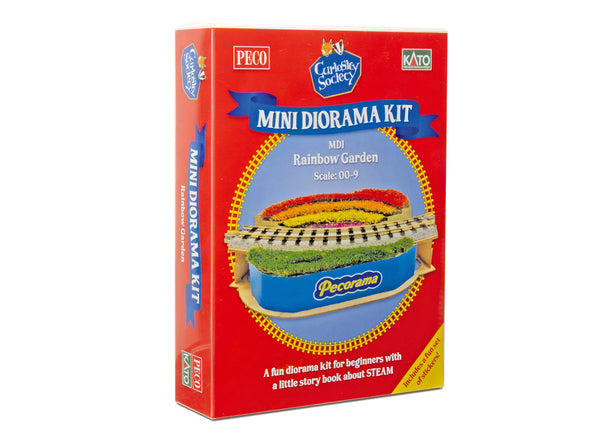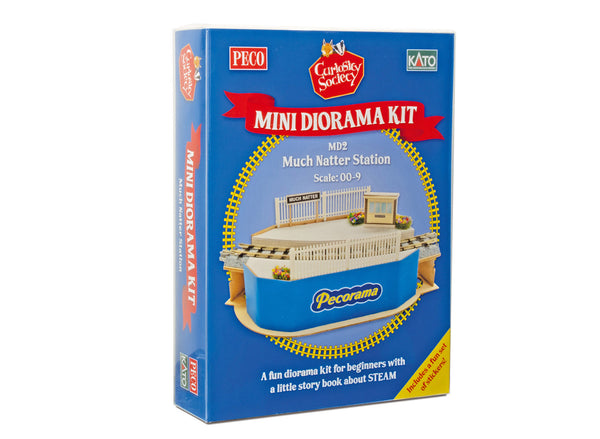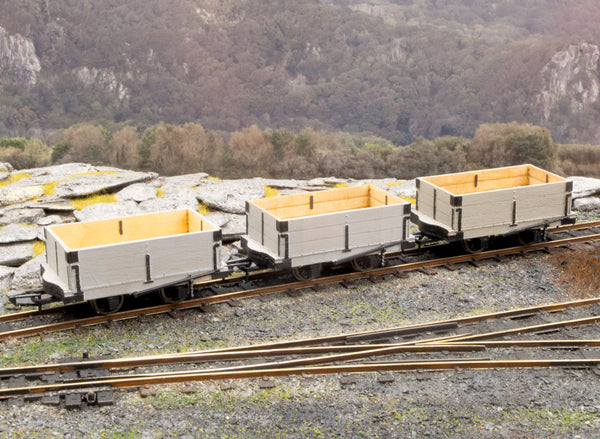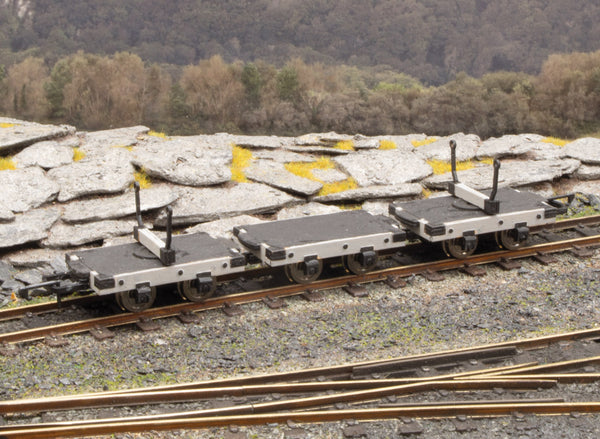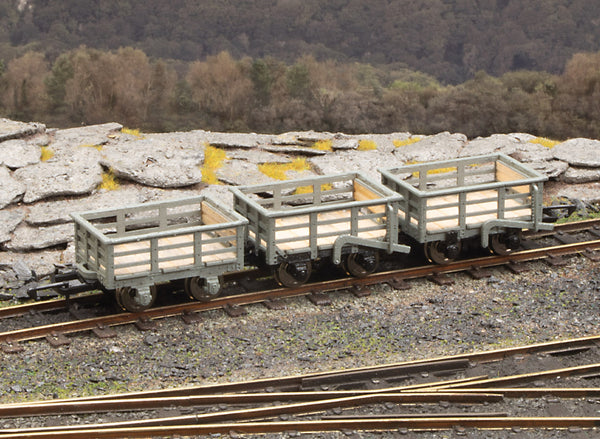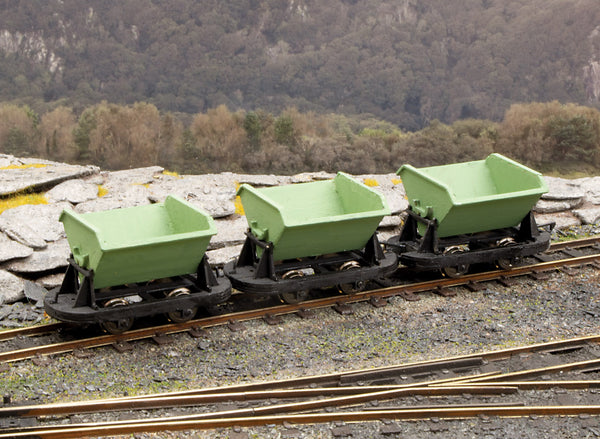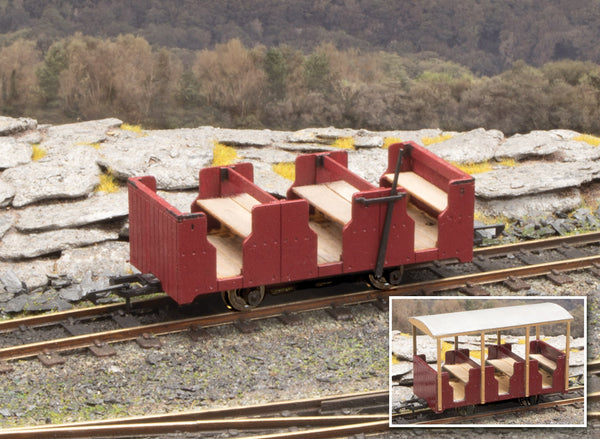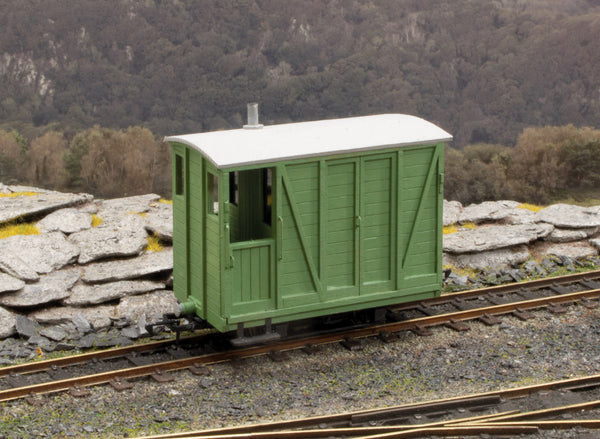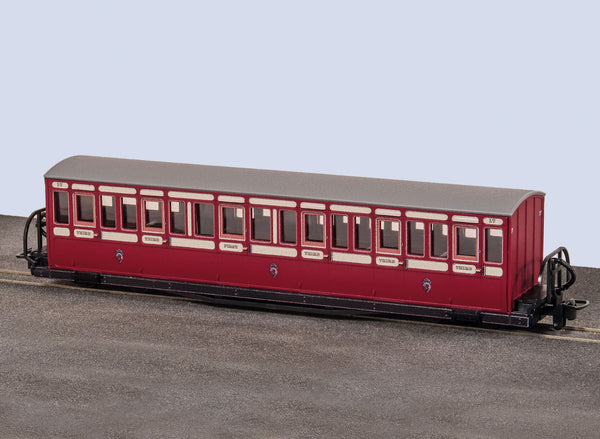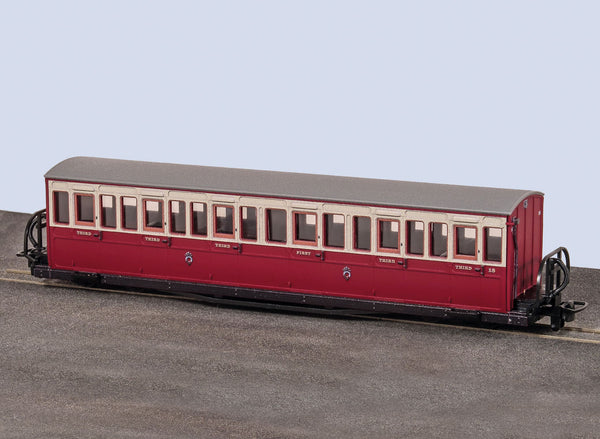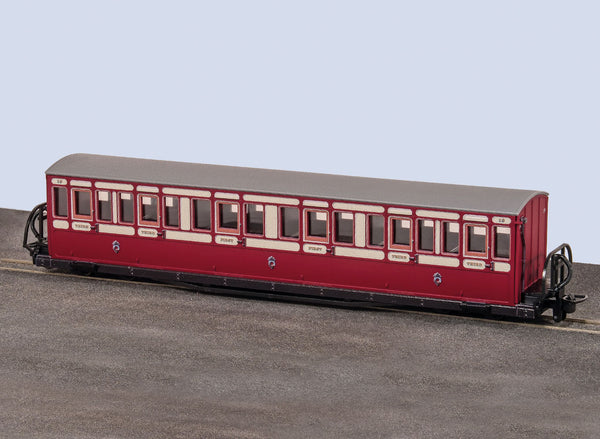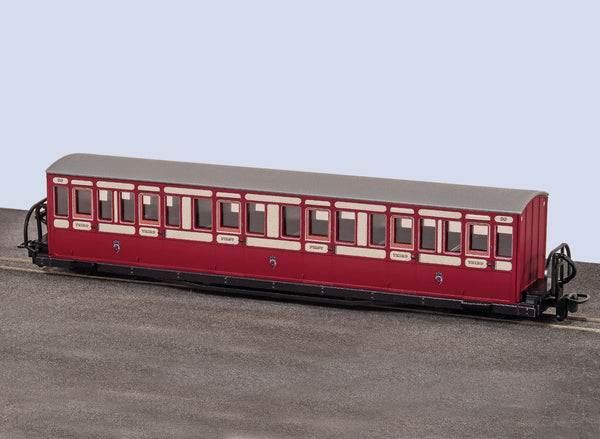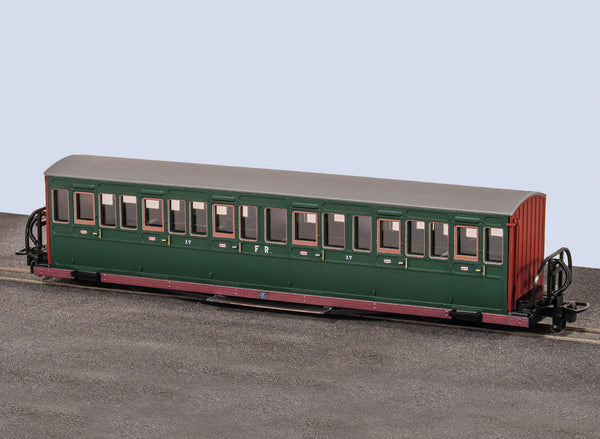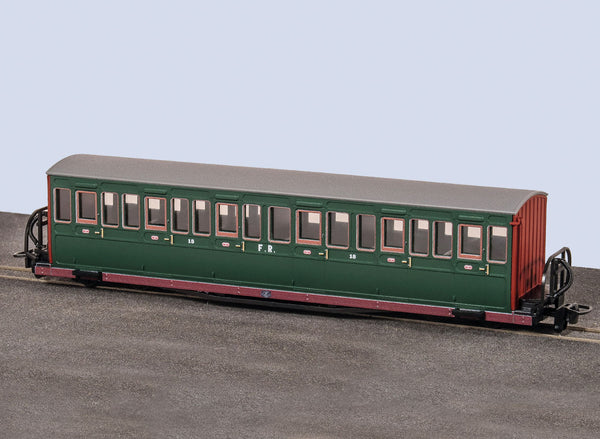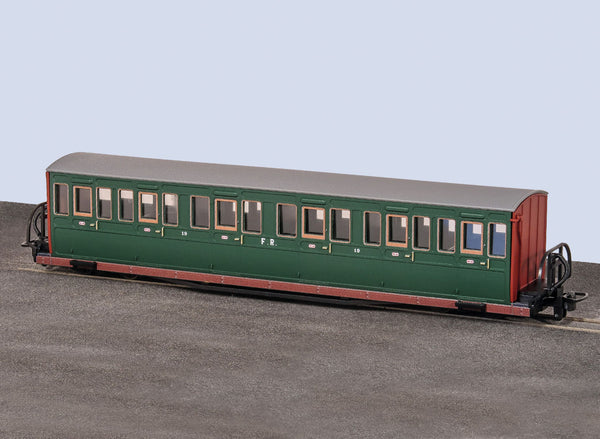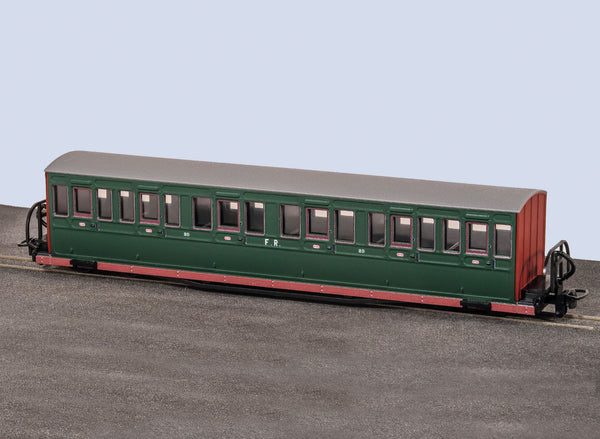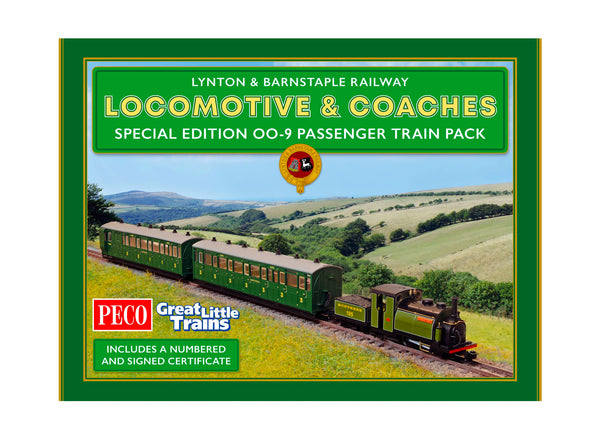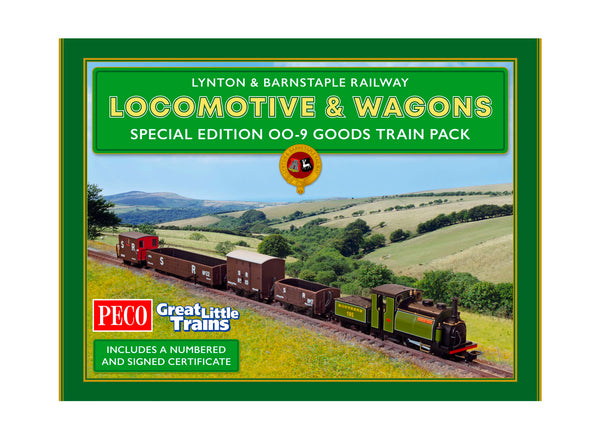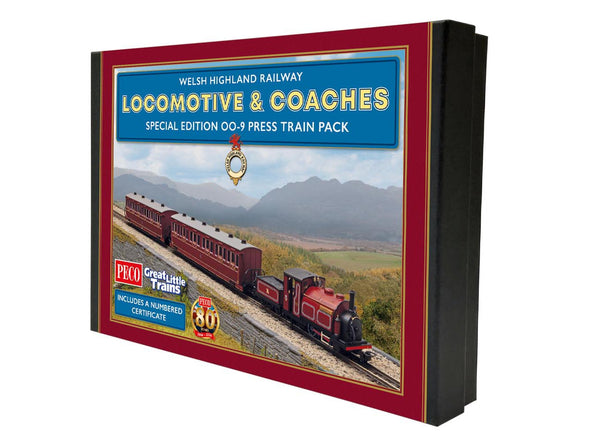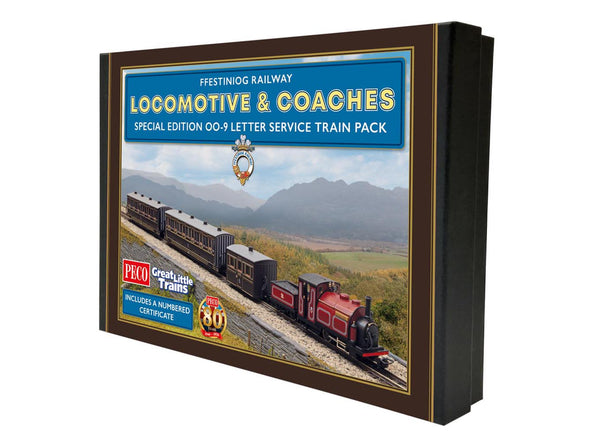DURCHSUCHEN SIE PECO-PRODUKTE
Stöbern Sie durch unser komplettes Produktportfolio.
41 Products Found
FR Short 'Bowsider' Bogie Coach - Early Preservation - Green 17
FR Short 'Bowsider' Bogie Coach - Early Preservation - Green 18
FR Short 'Bowsider' Bogie Coach - Early Preservation - Green 19
FR Short 'Bowsider' Bogie Coach - Early Preservation - Green 20
OO-9 Center Observation Coach Lynton und Barnstaple Livery Nr. 7
Diese fein detaillierten, fahrbereiten Waggons und Waggons sind genau dem rollenden Material der Lynton and Barnstaple Railway nachempfunden, sowohl als eigenständige Eisenbahn als auch nach deren Eingliederung in die Southern Railway im Jahr 1922. Sie sind für diese Modellbauer auch bemalt, aber unbeschriftet erhältlich die sie für den Einsatz auf anderen Linien anpassen möchten.
OO-9 Center Observation Coach Lynton und Barnstaple Livery Nr. 10
Diese fein detaillierten, fahrbereiten Waggons und Waggons sind genau dem rollenden Material der Lynton and Barnstaple Railway nachempfunden, sowohl als eigenständige Eisenbahn als auch nach deren Eingliederung in die Southern Railway im Jahr 1922. Sie sind für diese Modellbauer auch bemalt, aber unbeschriftet erhältlich die sie für den Einsatz auf anderen Linien anpassen möchten.
Kreuzung, Doppelrutsch
Doppelschleusen können wertvollen Platz an Bahnhofsvorfahrten, Kreuzungen usw. sparen und sind bei europäischen Eisenbahnen weit verbreitet.
Dieses 12-mm-Gleissystem ist in H0 genau nach dem Vorbild der in Europa, insbesondere in der Schweiz, verbreiteten Meterspurgleise gestaltet. Es ist auch nützlich für die Modellierung der 3 Fuß 6 Zoll langen Strecke, die im südlichen Afrika, Japan, Australien, Norwegen und Teilen Südamerikas zu finden ist; Im 4-mm-Maßstab entspricht die Spurweite den vielen Linien mit einer Spurweite von 3 Fuß, die früher in Irland und auf der Isle of Man zu finden waren. Diese vielseitige Schiene kann auch für den Modellbau im TT-Bereich (Maßstab 3 mm/ft) verwendet werden.
OO-9 Kleine englische PECO/KATO-Lokomotive – „Prince“
Bewundern Sie die brandneue Ffestiniog Railway Small England 0-4-0ST+T-Lokomotive „Prince“, die gemeinsam von PECO und dem bekannten japanischen Modelleisenbahnhersteller Kato produziert wurde.
Ausgeführt als „Prinzessin“ Nr. 1 und „Prinz“ Nr. 2, beide in kastanienbrauner Lackierung mit historischem Ffestiniog-Eisenbahn-Design.
OO-9 Kleine englische PECO/KATO-Lokomotive – „Prince“
Bewundern Sie die brandneue Ffestiniog Railway Small England 0-4-0ST+T-Lokomotive „Prince“, die gemeinsam von PECO und dem bekannten japanischen Modelleisenbahnhersteller Kato produziert wurde.
Ausgeführt als „Prinzessin“ Nr. 1 und „Prinz“ Nr. 2, beide in kastanienbrauner Lackierung mit historischem Ffestiniog-Eisenbahn-Design.
OO-9 Kleine englische PECO/KATO-Lokomotive – „Prince“
Bewundern Sie die brandneue Ffestiniog Railway Small England 0-4-0ST+T-Lokomotive „Prince“, die gemeinsam von PECO und dem bekannten japanischen Modelleisenbahnhersteller Kato produziert wurde.
Ausgeführt als „Prinzessin“ Nr. 1 und „Prinz“ Nr. 2, beide in kastanienbrauner Lackierung mit historischem Ffestiniog-Eisenbahn-Design.
OO-9 Kleine englische PECO/KATO-Lokomotive – „Prince“
Bewundern Sie die brandneue Ffestiniog Railway Small England 0-4-0ST+T-Lokomotive „Prince“, die gemeinsam von PECO und dem bekannten japanischen Modelleisenbahnhersteller Kato produziert wurde.
Ausgeführt als „Prinzessin“ Nr. 1 und „Prinz“ Nr. 2, beide in kastanienbrauner Lackierung mit historischem Ffestiniog-Eisenbahn-Design.
GWR-Bahnhofsgebäude aus Holz (Monkton Combe)
Monkton Combe, einst eine Zwischenstation der lange geschlossenen Camerton-Filiale in der Nähe von Bath, rückte 1952 ins Rampenlicht, als es als Drehort für die berühmte Ealing-Komödie „The Titfield Thunderbolt“ ausgewählt wurde.
GWR-Bahnhofsgebäude aus Holz
NEUE Holzbausätze mit Laserschnitt
Nach der Veröffentlichung unserer viktorianischen Häuser sind wir mit diesen eher zweckmäßigen Hausbausätzen, die auf einem Design basieren, das erstmals in den 1960er Jahren erschien, ein Jahrhundert weitergegangen. Wir alle haben diese Häuser gesehen – sie sind überall in Großbritannien zu finden und bilden ein vertrautes Merkmal in praktisch jeder Stadt.
Es sind 3 Bausätze erhältlich: Flachrelief-Vorder- und Rückseiten und der vollständige Bausatz. Der Bausatz ist einfach und zufriedenstellend, die lasergeschnittenen Details sind äußerst fein und weisen wunderbare Ziegel- und Fliesenstrukturen auf der Oberfläche auf. Die Modelle verfügen außerdem über Dachrinnen und Fallrohre, eine separate Veranda an der Vorderseite und Jalousien in den Fenstern, die nach Wunsch positioniert werden können. Nach dem Bau können die Modelle nach den individuellen Wünschen des Modellbauers bemalt werden.
Man kann sich gut eine Reihe dieser Häuserrückseiten aus den 1960er Jahren entlang der Eisenbahnstrecke oder eine kleine Wohnsiedlung in der Nähe des Bahnhofs vorstellen – eine perfekte Szene auf dem Gleis, die mit verschiedenen anderen Zubehörteilen von PECO, Ratio, Wills und Harburn Hamlet aufgewertet werden kann.
GWR-Bahnhofsgebäude aus Holz
NEUE Holzbausätze mit Laserschnitt
Nach der Veröffentlichung unserer viktorianischen Häuser sind wir mit diesen eher zweckmäßigen Hausbausätzen, die auf einem Design basieren, das erstmals in den 1960er Jahren erschien, ein Jahrhundert weitergegangen. Wir alle haben diese Häuser gesehen – sie sind überall in Großbritannien zu finden und bilden ein vertrautes Merkmal in praktisch jeder Stadt.
Es sind 3 Bausätze erhältlich: Flachrelief-Vorder- und Rückseiten und der vollständige Bausatz. Der Bausatz ist einfach und zufriedenstellend, die lasergeschnittenen Details sind äußerst fein und weisen wunderbare Ziegel- und Fliesenstrukturen auf der Oberfläche auf. Die Modelle verfügen außerdem über Dachrinnen und Fallrohre, eine separate Veranda an der Vorderseite und Jalousien in den Fenstern, die nach Wunsch positioniert werden können. Nach dem Bau können die Modelle nach den individuellen Wünschen des Modellbauers bemalt werden.
Man kann sich gut eine Reihe dieser Häuserrückseiten aus den 1960er Jahren entlang der Eisenbahnstrecke oder eine kleine Wohnsiedlung in der Nähe des Bahnhofs vorstellen – eine perfekte Szene auf dem Gleis, die mit verschiedenen anderen Zubehörteilen von PECO, Ratio, Wills und Harburn Hamlet aufgewertet werden kann.
GWR-Bahnhofsgebäude aus Holz
NEUE Holzbausätze mit Laserschnitt
Nach der Veröffentlichung unserer viktorianischen Häuser sind wir mit diesen eher zweckmäßigen Hausbausätzen, die auf einem Design basieren, das erstmals in den 1960er Jahren erschien, ein Jahrhundert weitergegangen. Wir alle haben diese Häuser gesehen – sie sind überall in Großbritannien zu finden und bilden ein vertrautes Merkmal in praktisch jeder Stadt.
Es sind 3 Bausätze erhältlich: Flachrelief-Vorder- und Rückseiten und der vollständige Bausatz. Der Bausatz ist einfach und zufriedenstellend, die lasergeschnittenen Details sind äußerst fein und weisen wunderbare Ziegel- und Fliesenstrukturen auf der Oberfläche auf. Die Modelle verfügen außerdem über Dachrinnen und Fallrohre, eine separate Veranda an der Vorderseite und Jalousien in den Fenstern, die nach Wunsch positioniert werden können. Nach dem Bau können die Modelle nach den individuellen Wünschen des Modellbauers bemalt werden.
Man kann sich gut eine Reihe dieser Häuserrückseiten aus den 1960er Jahren entlang der Eisenbahnstrecke oder eine kleine Wohnsiedlung in der Nähe des Bahnhofs vorstellen – eine perfekte Szene auf dem Gleis, die mit verschiedenen anderen Zubehörteilen von PECO, Ratio, Wills und Harburn Hamlet aufgewertet werden kann.
Hudson Rugga V-Skips (Yellow)
The familiar Rugga V-Skip 'tipping' wagon design was introduced in the 1930s - a development of the Robert Hudson company, based in Leeds. They could be supplied to the customer's specific requirements, with a skip size ranging from 13.5 to 54 cubic feet (0.38 to 1.53 cubic metres), and in most track gauges. The design allows the skip to tip in either direction, perfect for small industrial railways that needed to move and unload materials quickly and efficiently. The company even boasted that at any one time several thousand could be supplied from stock! These are supplied in an attractive display box of three.
Hudson Rugga V-Skips (Green)
The familiar Rugga V-Skip 'tipping' wagon design was introduced in the 1930s - a development of the Robert Hudson company, based in Leeds. They could be supplied to the customer's specific requirements, with a skip size ranging from 13.5 to 54 cubic feet (0.38 to 1.53 cubic metres), and in most track gauges. The design allows the skip to tip in either direction, perfect for small industrial railways that needed to move and unload materials quickly and efficiently. The company even boasted that at any one time several thousand could be supplied from stock! These are supplied in an attractive display box of three.
GWR-Bahnhofsgebäude aus Holz (Monkton Combe)
Monkton Combe, einst eine Zwischenstation der lange geschlossenen Camerton-Filiale in der Nähe von Bath, rückte 1952 ins Rampenlicht, als es als Drehort für die berühmte Ealing-Komödie „The Titfield Thunderbolt“ ausgewählt wurde.
GWR-Bahnhofsgebäude aus Holz (Monkton Combe)
Monkton Combe, einst eine Zwischenstation der lange geschlossenen Camerton-Filiale in der Nähe von Bath, rückte 1952 ins Rampenlicht, als es als Drehort für die berühmte Ealing-Komödie „The Titfield Thunderbolt“ ausgewählt wurde.
OO-9 Bug Box Coach, Lackierung der 1970er/80er Jahre, Zoowagen
Unsere NEUEN „Bug Box“-Wagen der Ffestiniog Railway tragen die schlichte rote Lackierung aus der Denkmalschutzzeit der 1970er und 1980er Jahre. Sie mögen schlicht sein, aber wenn Sie genau hinschauen, werden Sie feststellen, dass es tatsächlich viele sehr feine Details gibt, darunter das FR-Emblem, die Türgriffe und die laufenden Nummern.
OO-9 Bug Box Coach, Lackierung der 1970er/80er Jahre, Zoowagen
Unsere NEUEN „Bug Box“-Wagen der Ffestiniog Railway tragen die schlichte rote Lackierung aus der Denkmalschutzzeit der 1970er und 1980er Jahre. Sie mögen schlicht sein, aber wenn Sie genau hinschauen, werden Sie feststellen, dass es tatsächlich viele sehr feine Details gibt, darunter das FR-Emblem, die Türgriffe und die laufenden Nummern.
GWR-Bahnhofsgebäude aus Holz (Monkton Combe)
Monkton Combe, einst eine Zwischenstation der lange geschlossenen Camerton-Filiale in der Nähe von Bath, rückte 1952 ins Rampenlicht, als es als Drehort für die berühmte Ealing-Komödie „The Titfield Thunderbolt“ ausgewählt wurde.
GWR-Bahnhofsgebäude aus Holz (Monkton Combe)
Monkton Combe, einst eine Zwischenstation der lange geschlossenen Camerton-Filiale in der Nähe von Bath, rückte 1952 ins Rampenlicht, als es als Drehort für die berühmte Ealing-Komödie „The Titfield Thunderbolt“ ausgewählt wurde.
4-Rad-Wagenfahrgestell
0–16,5 Coach-Teile zur individuellen Anpassung der OR-31- und OR-32 Coach-Bausätze; auch für Selbstbauprojekte.
4-Rad-Wagenfahrgestell
0–16,5 Coach-Teile zur individuellen Anpassung der OR-31- und OR-32 Coach-Bausätze; auch für Selbstbauprojekte.
4-Rad-Wagenfahrgestell
0–16,5 Coach-Teile zur individuellen Anpassung der OR-31- und OR-32 Coach-Bausätze; auch für Selbstbauprojekte.
4-Rad-Wagenfahrgestell
0–16,5 Coach-Teile zur individuellen Anpassung der OR-31- und OR-32 Coach-Bausätze; auch für Selbstbauprojekte.
4-Rad-Wagenfahrgestell
0–16,5 Coach-Teile zur individuellen Anpassung der OR-31- und OR-32 Coach-Bausätze; auch für Selbstbauprojekte.
4-Rad-Wagenfahrgestell
0–16,5 Coach-Teile zur individuellen Anpassung der OR-31- und OR-32 Coach-Bausätze; auch für Selbstbauprojekte.
FR Short 'Bowsider' Coach - Red & Cream No.17
The Ffestiniog Railway operated two pairs of bogie coaches numbered 17-20 and built by Brown Marshalls & Co and Gloucester Wagon Co. They were known as ‘Bowsiders’ because of the tumblehome shape of their sides. Numbers 17 and 18, built in 1876 are shorter with one 1st class compartment. Numbers 19 and 20, built in 1879 are longer with two 1st class compartments. All four are still in service on the Ffestiniog Railway today.
The red and cream livery was first applied to a rake of carriages in 1987 for the ‘Mountain Prince’ train service. Carriage 20 was the first Bowsider to appear in the livery.
Carriages 17 and 18 had cream applied to the full upper half of the carriage. 17 had the mouldings reinstated in 1990 as depicted by GR-602A. 18 continued to have cream across the upper half throughout its time in the scheme, as represented by GR-602B. Note the ‘Brown Marshalls & Co. Ltd’ builders plate printed on the ends of the carriage.
All four Bowsiders were repainted into historic liveries in the 2000s, but the red and cream colour scheme is still seen today on the more modern carriages
FR Short 'Bowsider' Coach - Red & Cream No.18
The Ffestiniog Railway operated two pairs of bogie coaches numbered 17-20 and built by Brown Marshalls & Co and Gloucester Wagon Co. They were known as ‘Bowsiders’ because of the tumblehome shape of their sides. Numbers 17 and 18, built in 1876 are shorter with one 1st class compartment. Numbers 19 and 20, built in 1879 are longer with two 1st class compartments. All four are still in service on the Ffestiniog Railway today.
The red and cream livery was first applied to a rake of carriages in 1987 for the ‘Mountain Prince’ train service. Carriage 20 was the first Bowsider to appear in the livery.
Carriages 17 and 18 had cream applied to the full upper half of the carriage. 17 had the mouldings reinstated in 1990 as depicted by GR-602A. 18 continued to have cream across the upper half throughout its time in the scheme, as represented by GR-602B. Note the ‘Brown Marshalls & Co. Ltd’ builders plate printed on the ends of the carriage.
All four Bowsiders were repainted into historic liveries in the 2000s, but the red and cream colour scheme is still seen today on the more modern carriages
FR Long 'Bowsider' Coach - Red & Cream No.19
The Ffestiniog Railway operated two pairs of bogie coaches numbered 17-20 and built by Brown Marshalls & Co and Gloucester Wagon Co. They were known as ‘Bowsiders’ because of the tumblehome shape of their sides. Numbers 17 and 18, built in 1876 are shorter with one 1st class compartment. Numbers 19 and 20, built in 1879 are longer with two 1st class compartments. All four are still in service on the Ffestiniog Railway today.
The red and cream livery was first applied to a rake of carriages in 1987 for the ‘Mountain Prince’ train service. Carriage 20 was the first Bowsider to appear in the livery.
Carriages 17 and 18 had cream applied to the full upper half of the carriage. 17 had the mouldings reinstated in 1990 as depicted by GR-602A. 18 continued to have cream across the upper half throughout its time in the scheme, as represented by GR-602B. Note the ‘Brown Marshalls & Co. Ltd’ builders plate printed on the ends of the carriage.
All four Bowsiders were repainted into historic liveries in the 2000s, but the red and cream colour scheme is still seen today on the more modern carriages
FR Long 'Bowsider' Coach - Red & Cream No.20
The Ffestiniog Railway operated two pairs of bogie coaches numbered 17-20 and built by Brown Marshalls & Co and Gloucester Wagon Co. They were known as ‘Bowsiders’ because of the tumblehome shape of their sides. Numbers 17 and 18, built in 1876 are shorter with one 1st class compartment. Numbers 19 and 20, built in 1879 are longer with two 1st class compartments. All four are still in service on the Ffestiniog Railway today.
The red and cream livery was first applied to a rake of carriages in 1987 for the ‘Mountain Prince’ train service. Carriage 20 was the first Bowsider to appear in the livery.
Carriages 17 and 18 had cream applied to the full upper half of the carriage. 17 had the mouldings reinstated in 1990 as depicted by GR-602A. 18 continued to have cream across the upper half throughout its time in the scheme, as represented by GR-602B. Note the ‘Brown Marshalls & Co. Ltd’ builders plate printed on the ends of the carriage.
All four Bowsiders were repainted into historic liveries in the 2000s, but the red and cream colour scheme is still seen today on the more modern carriages
FR Short 'Bowsider' Coach - Colonel Stephens No.17
The Ffestiniog Railway operated two pairs of bogie coaches numbered 17-20 and built by Brown Marshalls & Co and Gloucester Wagon Co. They were known as ‘Bowsiders’ because of the tumblehome shape of their sides. Numbers 17 and 18, built in 1876 are shorter with one 1st class compartment. Numbers 19 and 20, built in 1879 are longer with two 1st class compartments. All four are still in service on the Ffestiniog Railway today.
In the 1920s the elaborate liveries of the Victorian era were replaced with a simple scheme of green with red end panels. It became known as the ‘Colonel Stephens’ livery, after the General Manager of the Ffestiniog Railway from 1925 until his passing in 1931. The colour scheme was used until the end of passenger operations in 1939, sometimes alongside other colours such as yellow, in the mid 1930s.
Green with red ends was applied to carriage No.20 once again from 2005 until 2024, as depicted by GR-623B.
FR Short 'Bowsider' Coach - Colonel Stephens No.18
The Ffestiniog Railway operated two pairs of bogie coaches numbered 17-20 and built by Brown Marshalls & Co and Gloucester Wagon Co. They were known as ‘Bowsiders’ because of the tumblehome shape of their sides. Numbers 17 and 18, built in 1876 are shorter with one 1st class compartment. Numbers 19 and 20, built in 1879 are longer with two 1st class compartments. All four are still in service on the Ffestiniog Railway today.
In the 1920s the elaborate liveries of the Victorian era were replaced with a simple scheme of green with red end panels. It became known as the ‘Colonel Stephens’ livery, after the General Manager of the Ffestiniog Railway from 1925 until his passing in 1931. The colour scheme was used until the end of passenger operations in 1939, sometimes alongside other colours such as yellow, in the mid 1930s.
Green with red ends was applied to carriage No.20 once again from 2005 until 2024, as depicted by GR-623B.
FR Long 'Bowsider' Coach - Colonel Stephens No.19
The Ffestiniog Railway operated two pairs of bogie coaches numbered 17-20 and built by Brown Marshalls & Co and Gloucester Wagon Co. They were known as ‘Bowsiders’ because of the tumblehome shape of their sides. Numbers 17 and 18, built in 1876 are shorter with one 1st class compartment. Numbers 19 and 20, built in 1879 are longer with two 1st class compartments. All four are still in service on the Ffestiniog Railway today.
In the 1920s the elaborate liveries of the Victorian era were replaced with a simple scheme of green with red end panels. It became known as the ‘Colonel Stephens’ livery, after the General Manager of the Ffestiniog Railway from 1925 until his passing in 1931. The colour scheme was used until the end of passenger operations in 1939, sometimes alongside other colours such as yellow, in the mid 1930s.
Green with red ends was applied to carriage No.20 once again from 2005 until 2024, as depicted by GR-623B.
FR Long 'Bowsider' Coach - Colonel Stephens No.20
The Ffestiniog Railway operated two pairs of bogie coaches numbered 17-20 and built by Brown Marshalls & Co and Gloucester Wagon Co. They were known as ‘Bowsiders’ because of the tumblehome shape of their sides. Numbers 17 and 18, built in 1876 are shorter with one 1st class compartment. Numbers 19 and 20, built in 1879 are longer with two 1st class compartments. All four are still in service on the Ffestiniog Railway today.
In the 1920s the elaborate liveries of the Victorian era were replaced with a simple scheme of green with red end panels. It became known as the ‘Colonel Stephens’ livery, after the General Manager of the Ffestiniog Railway from 1925 until his passing in 1931. The colour scheme was used until the end of passenger operations in 1939, sometimes alongside other colours such as yellow, in the mid 1930s.
Green with red ends was applied to carriage No.20 once again from 2005 until 2024, as depicted by GR-623B.
Special Edition OO-9 Passenger Train Pack
Alle Eisenbahnunternehmen verfügten über einen eigenen Bestand an Fahrzeugen für den Transport von Gütern und Gütern innerhalb ihres Streckennetzes und bei Bedarf auch auf die Strecken anderer Unternehmen. Diese wurden bei der Verstaatlichung in die British Railways integriert; Einige von ihnen sollten im Zuge der Sektorisierung noch einmal neu gestaltet werden, da das Netzwerk darauf vorbereitet war, wieder in Privatbesitz überzugehen. Alle Peco-Wagen verfügen über freilaufende Räder mit Steckachsen. Die ELC-Kupplung ist zwar mit den Standard-N-Spur-Kupplungen kompatibel, sorgt jedoch für einen realistischen Abstand zwischen den Fahrzeugen und ermöglicht die Verwendung des elektromagnetischen Entkopplers PL-25 zum Fernabkuppeln.
Special Edition OO-9 Goods Train Pack
Alle Eisenbahnunternehmen verfügten über einen eigenen Bestand an Fahrzeugen für den Transport von Gütern und Gütern innerhalb ihres Streckennetzes und bei Bedarf auch auf die Strecken anderer Unternehmen. Diese wurden bei der Verstaatlichung in die British Railways integriert; Einige von ihnen sollten im Zuge der Sektorisierung noch einmal neu gestaltet werden, da das Netzwerk darauf vorbereitet war, wieder in Privatbesitz überzugehen. Alle Peco-Wagen verfügen über freilaufende Räder mit Steckachsen. Die ELC-Kupplung ist zwar mit den Standard-N-Spur-Kupplungen kompatibel, sorgt jedoch für einen realistischen Abstand zwischen den Fahrzeugen und ermöglicht die Verwendung des elektromagnetischen Entkopplers PL-25 zum Fernabkuppeln.
Special Edition OO-9 Press Train Pack (Welsh Highland Railway)
Alle Eisenbahnunternehmen verfügten über einen eigenen Bestand an Fahrzeugen für den Transport von Gütern und Gütern innerhalb ihres Streckennetzes und bei Bedarf auch auf die Strecken anderer Unternehmen. Diese wurden bei der Verstaatlichung in die British Railways integriert; Einige von ihnen sollten im Zuge der Sektorisierung noch einmal neu gestaltet werden, da das Netzwerk darauf vorbereitet war, wieder in Privatbesitz überzugehen. Alle Peco-Wagen verfügen über freilaufende Räder mit Steckachsen. Die ELC-Kupplung ist zwar mit den Standard-N-Spur-Kupplungen kompatibel, sorgt jedoch für einen realistischen Abstand zwischen den Fahrzeugen und ermöglicht die Verwendung des elektromagnetischen Entkopplers PL-25 zum Fernabkuppeln.
Special Edition OO-9 Letter Service Train Pack (Ffestiniog Railway)
Alle Eisenbahnunternehmen verfügten über einen eigenen Bestand an Fahrzeugen für den Transport von Gütern und Gütern innerhalb ihres Streckennetzes und bei Bedarf auch auf die Strecken anderer Unternehmen. Diese wurden bei der Verstaatlichung in die British Railways integriert; Einige von ihnen sollten im Zuge der Sektorisierung noch einmal neu gestaltet werden, da das Netzwerk darauf vorbereitet war, wieder in Privatbesitz überzugehen. Alle Peco-Wagen verfügen über freilaufende Räder mit Steckachsen. Die ELC-Kupplung ist zwar mit den Standard-N-Spur-Kupplungen kompatibel, sorgt jedoch für einen realistischen Abstand zwischen den Fahrzeugen und ermöglicht die Verwendung des elektromagnetischen Entkopplers PL-25 zum Fernabkuppeln.


